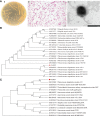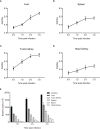Isolation, Identification, and Investigation of Pathogenic Bacteria From Common Carp (Cyprinus carpio) Naturally Infected With Plesiomonas shigelloides
- PMID: 35844551
- PMCID: PMC9279890
- DOI: 10.3389/fimmu.2022.872896
Isolation, Identification, and Investigation of Pathogenic Bacteria From Common Carp (Cyprinus carpio) Naturally Infected With Plesiomonas shigelloides
Abstract
Various bacterial diseases have caused great economic losses to the high-density and intensive aquaculture industry; however, the pathogenic mechanism underlying the large-scale challenged to caused by many bacteria remain unclear, making the prevention and treatment of these diseases difficult. In the present study, we isolated a bacterial strain from Cyprinus carpio having a typical bacterial disease and named it Cc2021. Through subsequent morphological observations, a regression challenge, biochemical identification, and 16S rRNA gene sequence analysis, we determined Cc2021 to be Plesiomonas shigelloides. Subsequently, we comprehensively investigated the pathogenicity of P. shigelloides in C. carpio through a regression challenge and assessed the underlying the pathogenic mechanism. Mortality results revealed that P. shigelloides is highly pathogenic and infects various tissues throughout the body, resulting in edema of the liver, spleen, and body and head kidneys. Histopathological analysis revealed obvious inflammation, bleeding, and necrosis in the intestine, spleen, and head kidney. The body's immune tissues actively produce complement C3, superoxide dismutase, and lysozyme after a challenge to resist bacterial invasion. With regard to the underlying pathogenesis of P. shigelloides, comparative transcriptome analysis revealed 876 upregulated genes and 828 downregulated genes in the intestine of C. carpio after the challenge. Analysis of differentially expressed unigenes revealed the involvement of major immune pathways, particularly the TNF signaling pathway, interleukin (IL)-17 signaling pathway, and Toll-like receptor signaling pathway. The present study provides new valuable information on the immune system and defense mechanisms of P. shigelloides.
Keywords: bacteria identification; comparative transcriptome; histopathological analysis; natural infection; pathogenicity; tissue bacterial load.
Copyright © 2022 Chen, Zhao, Chen, Wei, Luo, Li, Liu, Zhu, Hu and Luo.
Conflict of interest statement
The authors declare that the research was conducted in the absence of any commercial or financial relationships that could be construed as a potential conflict of interest.
Figures







Similar articles
-
Pathogenicity of Plesiomonas shigelloides causing mass mortalities of largemouth bass (Micropterus salmoides) and its induced host immune response.Fish Shellfish Immunol. 2023 Jan;132:108487. doi: 10.1016/j.fsi.2022.108487. Epub 2022 Dec 9. Fish Shellfish Immunol. 2023. PMID: 36503060
-
Mixed Infection in Common Carp (Cyprinus carpio) Caused by Aeromonas veronii, Aeromonas hydrophila, Plesiomonas shigelloides, and Citrobacter freundii.Animals (Basel). 2025 Mar 12;15(6):805. doi: 10.3390/ani15060805. Animals (Basel). 2025. PMID: 40150334 Free PMC article.
-
[Isolation and identification of a pathogenic Plesiomonas shigelloides from diseased grass carp].Wei Sheng Wu Xue Bao. 2014 Feb 4;54(2):229-35. Wei Sheng Wu Xue Bao. 2014. PMID: 24818472 Chinese.
-
Morphological and molecular characterization of Acanthostomum species with Plesiomonas shigelloides coinfection: Immunological and histopathological appraisal in Bagrus bajad.Microb Pathog. 2025 Mar;200:107365. doi: 10.1016/j.micpath.2025.107365. Epub 2025 Feb 7. Microb Pathog. 2025. PMID: 39924091
-
[Identification and pathological observation of a pathogenic Plesiomonas shigelloides strain isolated from cultured tilapia (Oreochromis niloticus)].Wei Sheng Wu Xue Bao. 2015 Jan 4;55(1):96-106. Wei Sheng Wu Xue Bao. 2015. PMID: 25958688 Chinese.
Cited by
-
Bacterial Communities and Antibiotic Resistance of Potential Pathogens Involved in Food Safety and Public Health in Fish and Water of Lake Karla, Thessaly, Greece.Pathogens. 2022 Dec 5;11(12):1473. doi: 10.3390/pathogens11121473. Pathogens. 2022. PMID: 36558807 Free PMC article.
-
Effects of Different Farming Models on Muscle Quality, Intestinal Microbiota Diversity, and Liver Metabolism of Rice Field Eel (Monopterus albus).Foods. 2025 Jul 5;14(13):2383. doi: 10.3390/foods14132383. Foods. 2025. PMID: 40647136 Free PMC article.
-
A brain microbiome in salmonids at homeostasis.Sci Adv. 2024 Sep 20;10(38):eado0277. doi: 10.1126/sciadv.ado0277. Epub 2024 Sep 18. Sci Adv. 2024. PMID: 39292785 Free PMC article.
-
Comparative analysis of three plasmids from Plesiomonas shigelloides strain MS-17-188 and their role in antimicrobial resistance.JAC Antimicrob Resist. 2024 Jul 19;6(4):dlae109. doi: 10.1093/jacamr/dlae109. eCollection 2024 Aug. JAC Antimicrob Resist. 2024. PMID: 39035015 Free PMC article.
-
First report of multidrug-resistant and pathogenic Plesiomonas shigelloides from endangered crested ibis (Nipponia nippon).BMC Vet Res. 2025 Apr 29;21(1):299. doi: 10.1186/s12917-025-04755-3. BMC Vet Res. 2025. PMID: 40301844 Free PMC article.
References
-
- Chen L, Xu J, Sun X, Xu P. Research Advances and Future Perspectives of Genomics and Genetic Improvement in Allotetraploid Common Carp. Rev Aquaculture (2021) 2(14):957–78. doi: 10.1111/raq.12636 - DOI
-
- Jung-Schroers V, Adamek M, Harris S, Syakuri H, Jung A, Irnazarow I, et al. . Response of the Intestinal Mucosal Barrier of Carp (Cyprinus Carpio) to a Bacterial Challenge by Aeromonas Hydrophila Intubation After Feeding With Beta-1,3/1,6-Glucan. J Fish Dis (2018) 41(7):1077–92. doi: 10.1111/jfd.12799 - DOI - PubMed
-
- Dworaczek K, Kurzylewska M, Laban M, Pekala-Safinska A, Marczak M, Turska-Szewczuk A. Structure of the Disaccharide Repeating Unit of O-Specific Polysaccharide Isolated From Aeromonas Veronii Strain Bs8 Pathogenic to Common Carp (Cyprinus Carpio). Carbohydr Res (2021) 500:108210. doi: 10.1016/j.carres.2020.108210 - DOI - PubMed
Publication types
MeSH terms
Substances
LinkOut - more resources
Full Text Sources
Research Materials
Miscellaneous

